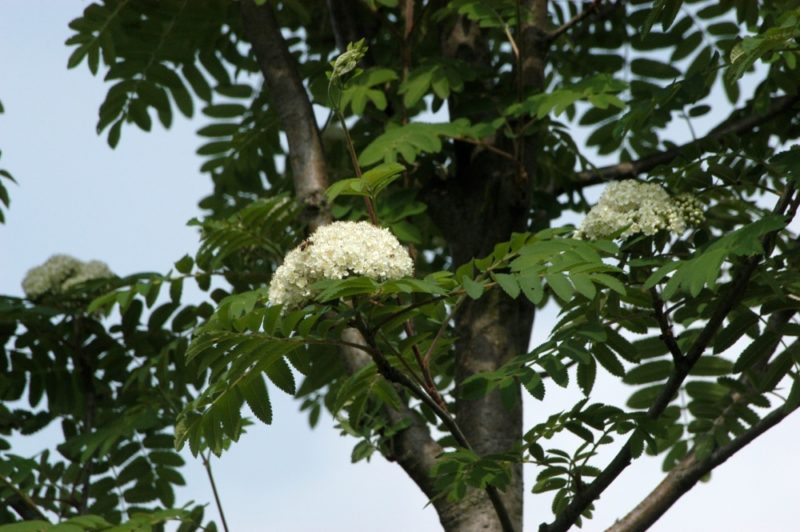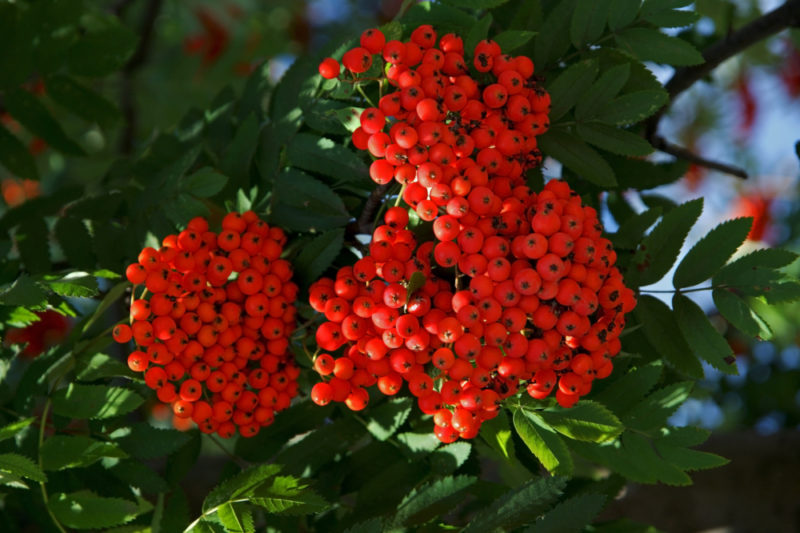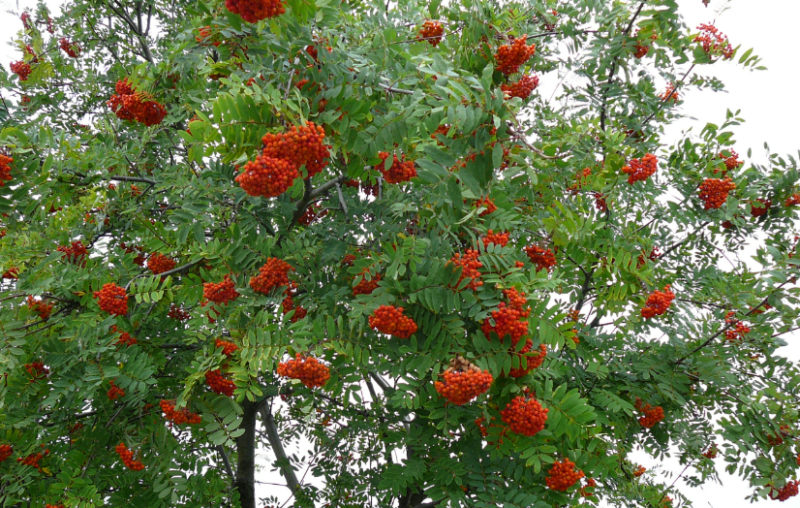Mountain ash ordinary - one of the invariable symbols of the Russian outback. This is a tree whose beauty and nobility are reflected in folk songs and lyric poems, in landscape painting and applied art. And despite this, the culture is undeservedly deprived of the attention of gardeners who consider it rustic for a neighborhood with exquisite hydrangeas or roses.
Material Content:
Description of the species and varieties
More than 80 species belonging to the Rowan genus are known, and half of them can be found in Russia and the CIS countries.
Mountain ash (Sorbus aucuparia) - deciduous tree up to 15 m high with a spreading and openwork crown. Her leaves are green, unpaired, by autumn they turn yellow-orange, fly around early.
Rowan blossoms in late spring - early summer, corymbose inflorescences adorn the tree for 2 weeks, after which fruit ovaries appear, which at the end of the season acquire red, orange, yellow, white and other colors depending on the variety form of a particular tree. They become more or less edible after the first frosts. However, the efforts of breeders have bred varieties that differ not only in the large size of the berries, but also with excellent taste.
For breeding work, mainly 2 varieties of mountain ash were used - p. Moravian and p. Nevezhinskaya.
Based on them, the following domestic varieties were created:
- “Bead” is a small tree up to 3 m long, with light green leaves and scarlet glossy fruits that are intolerant and have an interesting cranberry flavor.
- "Angri" is a tree with a translucent compact crown.Leaf blades are strongly jagged, have a light green color. The berries are bright orange, gathered in loose guards.
- “Cubic” - a high mountain ash (up to 10 m) with a wide pyramidal crown. The berries are large, red, slightly elongated with marked edges on the sides.
- "Sorbinka" is a popular variety, characterized by a good taste of fruits - juicy, without bitterness and astringency. The tree is small, with a compact crown.
- "Betafed" is a mountain ash of small height, with leaves of light green color and pink-yellow fruits having dessert taste. Winter-hardy and high-yielding.
- "Edulis" - a graceful tree up to 12 m tall, with a crown of narrow pyramidal shape. The leaves are soft green, large, and the berries are dark red, collected in large scutes.
- "Shiverwater Sidling" - a slender tree 10 - 12 m tall, with a pyramidal crown and a pronounced vertical habit. The leaves are dark green with a grayish tint, the fruits are red-orange.
The great Russian scientist-practitioner I.V. made a huge contribution to the refinement of the mountain ash by creating new varieties. Michurin. Thanks to his work, interspecific hybrids from crossing mountain ash with pear, hawthorn, medlar, chokeberry and other cultures from the Rosaceous family were bred. Such varieties as Pomegranate, Titan, Dessert, Burka, Likernaya and many others will not only decorate the garden, but also reward solid crops of healthy and tasty berries.
In addition to the above varieties of mountain ash, there are also very decorative varieties of it, interesting in the unusual color and shape of the leaves, the shape and size of the crown.
Brief descriptions of these species are presented below:
- “Globose” is a neat tree with a spherical crown with dark green, slightly twisted leaves and orange-red fruits in numerous guards. The diameter of the crown is up to 2 m, and the height of the tree depends on the level of grafting on the stem.
- "Fastigiata" is a rowan tree with a narrow columnar shape. The crown is elongated due to the thick skeletal branches directed vertically upward. The leaves are dark green, and the berries are the colors of pomegranate, very elegant and numerous.
- "Pendula", or weeping mountain ash - a tree with a tent-like shape of a crown formed by drooping skeletal branches. The height of the stem depends on the site of vaccination. An additional decoration is bright orange berries, collected in large guards.
The following two varieties are attractive due to the unusual leaves.
- “Aurea” in spring and early summer is dressed in soft lemon foliage, acquiring a light green hue by the middle of the season.
- "Laciniata" holds his gaze, thanks to the strongly dissected leaf blades.
The nuances of growing mountain ash
This is an unpretentious tree that can withstand short-term droughts, strong winds, gas pollution and severe frosts (up to -50 ° C).
It is for these reasons that it is widely used in urban landscaping, when creating large parks and forest gardens. But some features of its cultivation must be considered when choosing a permanent place.
- Mountain ash is an unsuitable tree for strengthening slopes, so it is planted on smooth surfaces.
- Culture needs a well-lit area, because in the shade it is impossible not only to wait for the harvest, but also to grow a beautiful slender tree. With a lack of light, it will be stunted, crooked and plain.
- Despite the drought tolerance of mountain ash, without proper watering, it will not be possible to harvest a worthy crop even from an adult tree.
- Groundwater level should not be higher than 2 m.
- Any soil is suitable, except for swampy and salt marshes.
- Rowan is only partially self-fertile plant, therefore, to get a good harvest, you must have at least two trees of different varieties on the site.
Outdoor landing
Planting of mountain ash is carried out in the usual time frame for such a culture - in the early spring before buds open or in autumn after leaf fall. A pit is prepared in advance so that the soil has time to settle.The dimensions of the recess depend on the size of the root system of the seedling, but if it is not coarse, then 60 cm in depth and 50-60 cm in diameter are usually enough.
To fill the landing pit, use the top layer of excavated soil, which is mixed with sheet soil and humus in equal proportions. Mountain ash can grow on depleted soils, but the ideal balance of beauty and productivity can be achieved only when creating optimal conditions for the growth of a young tree. Fertilizing during planting will not hurt: 300 g of double superphosphate and 200 g of wood ash or 50 g of potassium sulfate.
Advice! On clay soils, the pit will have to be made deeper by 10-15 cm and a drainage layer consisting of broken brick, slate or small stones should be laid on its bottom.
- The seedling is set in the center of the filled hole, spreading the roots, and is covered with the remains of fertile soil from above.
- It is not recommended to deepen the root neck, especially in grafted varieties.
- Around the stem, the earth is well compacted and watered abundantly from a watering can.
- Simultaneously with the filling of the pit, a support peg is usually installed.
- The trunk circle is mulched with organic materials: sawdust, straw, grass cut from a lawn mower.
Tree care
Growing mountain ash does not require much effort from the gardener. She, like any fruit tree, needs watering, top dressing and seasonal pruning for full development. Freshly rooted seedlings are particularly demanding on moisturizing. They should be watered at least once a week (in the absence of rain).
Provided that a well-composed fertile mixture for planting is provided, additional feeding of mountain ash is not necessary.
More adult specimens fertilize 3 times per season:
- At the beginning of spring, nitrogen fertilizers are introduced - urea or ammonium nitrate for a good increase in vegetative mass.
- In mid-summer, after flowering, complex mineral fertilizers with microelements are used for enhanced nutrition of the fruiting tree and better maturation of the growth of the second wave.
- In late August - early September, the final season is supplemented with phosphorus-potassium fertilizers to better prepare the specimen for winter cold.
How to trim
The first goal of pruning rowan berries is to create a strong skeleton that can withstand the load of fruiting branches in adulthood. The second is the formation of a crown evenly lit from all sides.
Tree pruning operations begin already from the 2nd year of plant life. The usual time is early spring, before the swelling of the kidneys.
First they do sanitary pruning, removing weak thin shoots, broken off branches growing inside the crown. The stamp is cleaned of lateral growths to the desired height, cut out shoots below the site of vaccination (if any).
Harvested varieties must be restrained in growth. To do this, remove the leader (central conductor) by cutting it to the side branch. All future skeletal branches are shortened by about 1/3. The angle of their departure from the trunk should be at least 45 °, otherwise in the future the tree may be threatened with a break. To change the angle, you must use stretch marks or pull branches in other ways.
Every year, it is necessary to ensure that shoots appearing at the cut top do not lead the tree to a height. Rowan branches can have 6 - 10 skeletal branches, and all of them are shortened to the upper internode every spring. All excess side shoots are removed to the ring. Cutting weeping and spherical shapes is carried out in accordance with accepted standards.
With age, mountain ash begins to bear fruit worse, annual growth is significantly reduced - the tree begins to age. Anti-aging pruning can help, in which skeletal branches shorten up to 3-4 years of wood.
Breeding methods
Species mountain ash is easily propagated by seeds. For this, fresh fruits are kneaded, the seeds are washed from the pulp and sown on a planting bed in the fall.During spring sowing, seeds must undergo a preliminary 2 - 3-month stratification, and they are planted in open ground at the end of April.
Already in the first year of life, seedlings can grow up to 30 - 40 cm. In the future, they can be used as stocks for varietal mountain ash, which do not retain their best properties during seed propagation. Vegetative methods are used for them - cuttings and vaccination.
Cuttings are cut from annual growths.
There are 2 methods:
- green cuttings;
- using lignified cuttings.
Green cuttings are cut in June from mature shoots, their length is 10 - 12 cm. For better rooting, stimulants are used: “Kornevin”, “Zircon”, “Heteroauxin”. For about 1 month, the cuttings should be in greenhouse conditions with regular spraying 2 times a day. Various substrates are used for rooting: peat + sand, vermiculite, perlite, clean sand.
Lignified cuttings are harvested at the beginning of winter. They are stored in the cellar until spring, and with the onset of heat they are planted in boxes with prepared soil.
Vaccination is usually done in the root neck or at the right height in the stump by the method of budding, i.e., by the kidney. The best time for this operation is the second half of the summer, when there is a second wave of sap flow (this period is easily evidenced by the easily separated bark). The kidney, as a rule, takes root within 2 weeks, and starts growing next spring.
Advice! To save space on the site and provide the best conditions for fruiting, you can plant 2 to 3 different varieties of mountain ash in the crown of a wild seedling.
Disease and Pest Prevention
If gardeners devote a lot of time and effort to protecting apple trees or pears, then the mountain ash is often left without attention, and in vain. After all, it can become a source of infection for other trees on the site, which means that it requires the same attention and care as all other crops.
Most often, mountain ash is affected by leaf diseases caused by fungi: septoria, rust, various spots. Prevention measures are the same - early spring treatment with any copper-containing preparation (Abiga-Peak, Khom, Bordeaux liquid, etc.).
Rowan is susceptible to attack by many species of isolated pests, that is, those who parasitize only on this crop. In this row, and mountain ash moth, and mountain ash mite, and mountain ash aphid, and mountain ash sawfly, and others.
Preventive spraying with drugs "Fufanon" or "Kemifos" will help to avoid danger. If time is lost and the number of pests rolls over, you will have to process the mountain ash in several stages. Instead of the above funds, you can use Aktaru, Inta-Vir, Iskra, Aktellik and others.
Scopes of mountain ash ordinary
Large juicy fruits of mountain ash have found their application in various fields of life: traditional medicine, cosmetology, veterinary medicine and cooking.
In folk medicine
Rowan berries have numerous healing beneficial properties due to their high content of B, C, K, E and PP vitamins, phytoncides and flavonoids, pectin and carotene, organic acids and the substance that makes them unique - sorbose.
- A decoction of rowan fruits will stop diarrhea and cope with vitamin deficiency.
- Fresh juice diluted with water is useful for SARS and flu.
- Some medicines for the treatment of the liver, gall bladder, and kidneys include mountain ash.
It regulates fat metabolism in the body, is an immunomodulator, it is used in the treatment of thrush and other fungal infections, and it is also used in case of a bazedovy disease.
In cooking
The collection of fruits of mountain ash is usually carried out in October - November after the first frost, when they gain enough sugars and partially lose their astringency. Compote, syrups and preserves are cooked from berries, marmalade, marshmallow and candied fruit are made, homemade tincture and wine are made. Piquant taste and rich color distinguish blanks of mountain ash.
It is not by chance that this tree enjoys good fame among the people, because the mountain ash is a real home amulet, and its fruits are a source of health and longevity.

















